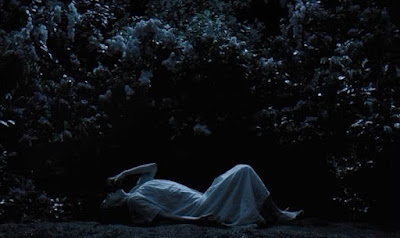I took the occasion of Robert Eggers' new film to watch three versions of Nosferatu in three days. I love the Murnau (I agree with Gilberto Perez that Dreyer's Vampyr "alone bears comparison" with it [The Material Ghost, p. 124], athough I am of the possibly heretical opinion that Vampyr is the greater of the two), but I'd managed somehow never to see Herzog's version before now.
Aside from the surprisingness of the fact that Murnau's film contains nothing at all about creating new vampires (something that Eggers, unlike Herzog, is faithful to; this seems to me one of the weaker aspects of the Herzog), one of the other very striking things about the Murnau is the suggestion that Orlok is somehow natural. The film is so much more interested in death than sex (more on this below), and death is the most natural thing in the world. This is what I take to be the import of the Van Helsing figure's lecture about venus flytraps and hydras: horror lies at the heart of nature rather than intruding from without. (Others have of course already noted this, including Simon Bacon.) Which makes it all the more surprising that Herzog did not explore this theme given his notorious fondness for it.
The thing that most struck me about the Herzog version (aside from the
fact that it may have the best joke in all three versions, when the
vampire apologises to Lucy for coming in uninvited) is the sense of the
inexorability of Nosferatu's arrival that it generates, possibly even
stronger than in Murnau's. Although the approach of the ship is more
frightening in the earlier film, it is the very lack tension that gives
the corresponding sequences their power in Herzog's version. What is a
day or two, let alone an hour or two, to fate? Death is coming either
way. (Nosferatu's pathos lies precisely in the parallel horror that for
him, this is not true. To be a vampire with a death wish is a terrible
thing. Let the Right One In and Only Lovers Left Alive are
two of the most engaging explorations of the curse of vampiric immortality, but they don't emphasize abject pain in the way that Herzog
does.) Thus I find Perez to be a little unfair to Herzog when he writes
of the plague ship's arrival in the town that "[t]he brisk rhythm of
Murnau's cutting builds up to the shot as an arresting point of
confluence, whereas in Herzog the shot is preceded by a leisurely
helicopter shot circling the ship at sea that generates little impetus
or anticipation" (p. 429, n. 6). This seems to me precisely the point,
and it is a distinct achievement of Herzog's film that it finds
something else to express with this sequence and thus avoids a futile
head-on confrontation with Murnau. (One other lovely detail from the
Herzog, just after this moment, which is both funny and terrifying, is
the little girl standing on the quay next to plague ship who sneezes.)
In Herzog's film science itself is a dusty superstition, personified in
Walter Ladengast's Van Helsing. Eggers, on the other hand, throws in all
the mundane occult nonsense that neither Murnau nor Herzog wanted
anything to do with. The film is not without its pleasures - Willem
Dafoe comes through unscathed through an impeccably judged level of
conviction, and both Simon McBurney and Orlok's voice are entertainingly
schlocky - but I remain puzzled as to the intended contribution of this
film as another Nosferatu, rather than just another vampire
movie. The routine jump scares and sometimes very unfortunate imagery
(the naked woman on a horse is pure Dungeons and Dragons) don't indicate
a film that has very much to say, and invoking another Murnau film (the
shadow of Orlok's hand stretching over the town summoning the ghost of
his Faust) didn't clarify anything for me. Given that the
relative lack of interest in eroticism is such a large part of what
distinguishes the two previous Nosferatus from what we think we
all know about movie vampires, I couldn't see that reintroducing it
achieved anything very much. (The obsessive retention of the names from
Murnau's version just underlined how little the films have to do with
each other.) It seems that female sexuality is excessive and
uncontrolled, a source of fear - like a sex-negative Poor Things. Turning Nosferatu at points into The Exorcist, as Eggers does, might be calculated to appeal to Mark Kermode but left me cold.



No comments:
Post a Comment